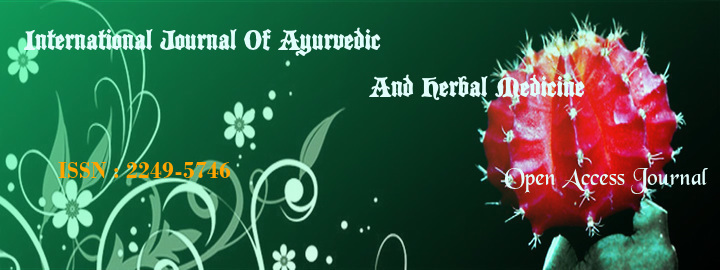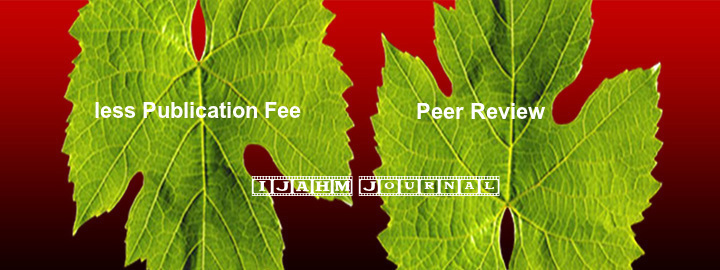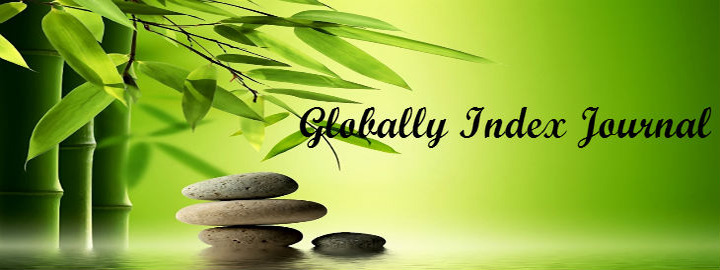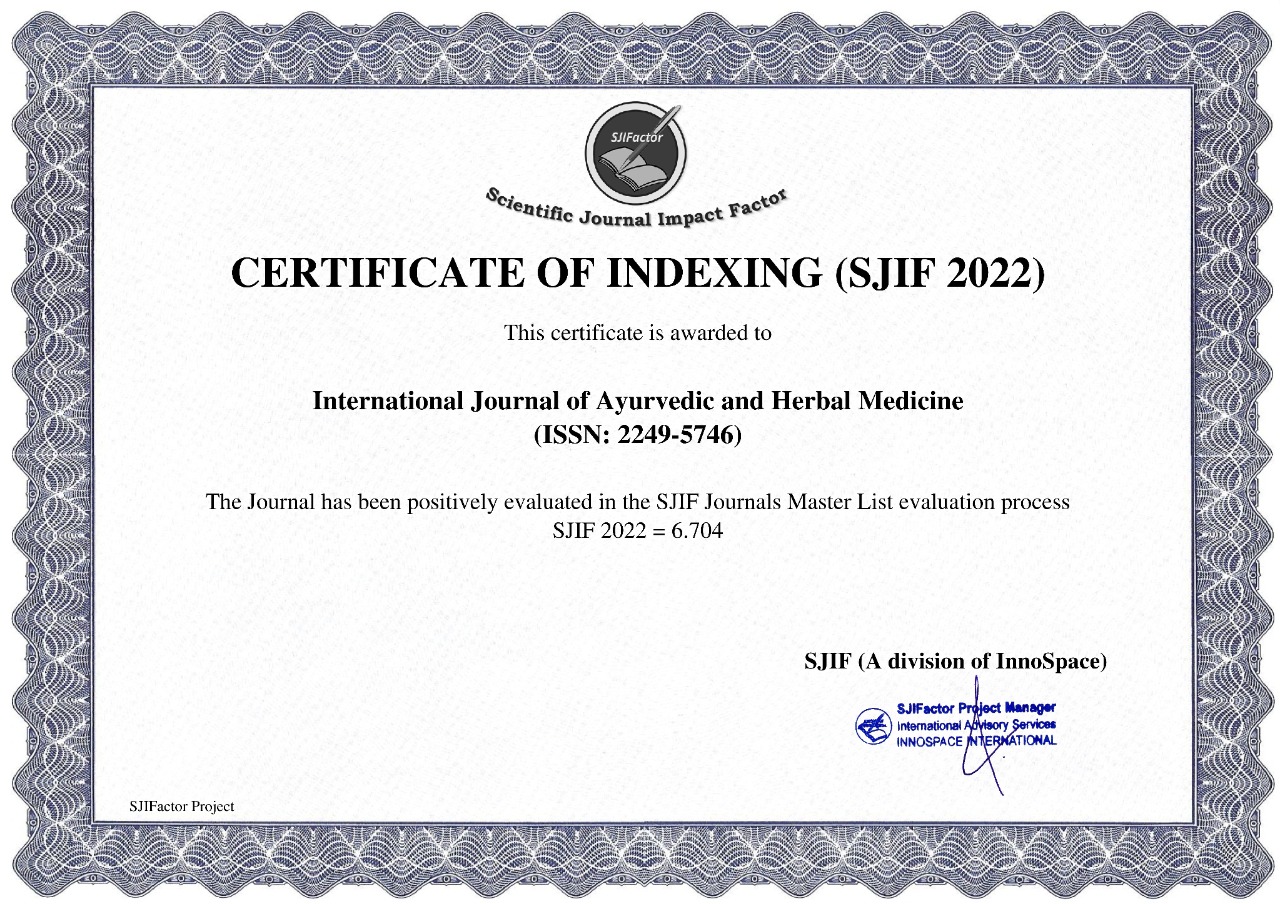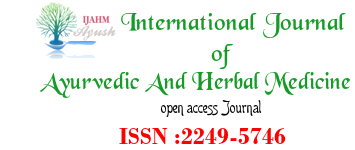


Dr. Khan Saba Mohd Athar1, Dr. Ismath Shameem2, Dr. Sahibole Suhail3, Dr. Siddiqui Aafreen4
1Assistant Professor, Dept. of Ilmul Qabalat wa Amraze Niswan, Luqman Unani Medical college (LUMC), Vijayapur India.
2Lecturer, Dept. of Ilmul Qabalat wa Amraze Niswan, NIUM, India.
3Assistant Professor, Dept. of Ilmul Jarahat, LUMC, Vijayapur India.
4Assistant Professor, Dept. of Moalajat, LUMC, Vijayapur India.
Abstract:-
Obesity represents a rapidly growing threat to the health of populations which has detrimental effect on fertility by disrupting the neuroendocrinal and ovulatory functions. One quarter of all obese infertile couples have an ovulatory disorder and 90% of those women with an ovulatory disorder have PCOD. Obese infertile women are at risk of type 2 diabetesmellitus, endometrial and breast cancer.Recent studies have shown that, obese women require higher doses of ovulation inducing drugs and has poor outcome with ART. These interventions are also associated with complications such as ovarian hyper stimulation syndrome, reduce ovarian reserve and pelvic adhesions.InUnani system of medicine, infertility is termed as “Uqr” which occurs due to defect in male mani (sperm) or female mani(ovum) or male and female reproductive organs.It is mentioned in various Unani literature that obesity is associated with infertility.Obesity(siman mufrit) is classified as a balghami marzwhich leads to zoa’fe jigar,sudda jigar,sue mizaj sada (barid ratab) and sue mizaj maddi (balghami) of the uterus, zo’afequwwate tawlide maniwhich alter the ovarian function which resultsin impaired follicle developmentand toole ihtebase mani (chronic anovulation);these factors are responsible for infertility. Principle of treatment includes elimination of cause of infertility (obesity), use of mudirre haiz advia having mufattih sudad property to induce menstruation,use of muwallide mani, muqawwi rahim & mu’ine hamladvia to help in conception. This review givesa complete description of physiology of reproduction, effect of obesity onfertility, diagnosis, principle of treatment and treatment in Unani perspective.
Key words: Infertility, Obesity, PCOD, Uqr, Siman Mufrit.
REFERENCES
1. Wilkes S, Murdoch A. Obesity and female fertility: A primary care perspective. J Fam Plann Reprod Health Care 2009; 35 (3):181-5.
2. Mascarenhas MN, Flaxman S, Boerma T, Vanderpoel S, Stevens GA. National, Regional, and Global Trends in Infertility Prevalence Since 1990: A Systematic Analysis of 277 Health Surveys. PLOS 2012 Dec; 9 (12): 1- 42.
3. Mascarenhas MN, Flaxman S, Boerma T, Vanderpoel S, Stevens GA. National, Regional, and Global Trends in Infertility Prevalence Since 1990: A Systematic Analysis of 277 Health Surveys. PLOS 2012 Dec; 9 (12): 1- 42.
4. Beall SA, Decherney A. The history and challenges surrounding ovarian stimulation in the treatment of infertility. Fertil Steril 2012 Apr; 97(4): 795-801.
5. Royal college of Obstetrician and Gynecologist. Fertility: Assessment and treatment for people with fertility problems. NICE Clinical Guidelines. 2nded. London: RCOG; 2013: 71. [www.rcog.org.uk]
6. Harrison CL, Lombard CB, Moran LJ, Teede HJ. Exercise therapy in polycystic ovary syndrome: A systematic review. Human Reproduction Update 2011;17(2): 171- 83.
7. Majoosi ABA. Kamilus Sana’a (Urdu translation by Kantoori GH). Vol I. New Delhi: Idarae Kitabul Shifa; 2010: 40, 155, 337, 534, 538-9.
8. Ibn Sina. Al Qanoon Fil Tibb (Urdu translation by Kantoori GH). New Delhi: Idarae Kitabul Shifa; 2010: 40, 155, 337, 534, 538-9, 1065-66, 1069-70, 1088-89, 1095-98, 1445-47.
9. Khan AA. Akseere Azam. New Delhi: Idarae Kitabul Shifa;2011:798-801, 806, 819-20.
10. Jurjani AH. Zakheerae Khawarzam Shahi (Urdu translation by Khan HH). New Delhi: Idarae Kitabul Shifa; 2010: 24, 27-8, 113, 372, 376, 601, 606-9.
11. Razi ABZ. Al Hawi Fil Tibb. Vol IX. New Delhi: CCRUM; 2001: 68, 72, 74, 77, 82, 84, 86-87, 90-91, 97, 102-3, 106-9, 111, 115-6, 151-2, 154-5, 157-60, 162, 167, 204-5.
12. Qumari AMH. Ghana Mana (Urdu translation). New Delhi: CCRUM; 2008: 369, 372-3, 386, 388-9, 391-2, 394-6, 410-13,417.
13. Tabri AR. Firdausul Hikmat (Urdu translation by Shah MA). New Delhi: Idarae Kiatabul Shifa; 2010: 112-3, 125-6, 254,257, 259, 261, 471.
14. Ranjbar SH, Nayebi N, Larijani B, Abdollahi M. A systematic review of the efficacy and safety of herbal medicines used in the treatment of obesity. World J Gastroenterol 2009; 15 (25): 3073-85.
15. Delvigne A, Rozenberg S. Epidemiology and prevention of ovarian hyperstimulation syndrome (OHSS): A review. Human Reproduction Update 2002; 8(6): 559-77.
16. Oriji VK. Laparoscopic ovarian drilling versus medical treatment in management of clomiphene citrate polycystic ovarian syndrome. World Journal of Laproscopic Surgery 2010 May-Aug; 3(2): 99-102.
17. O’ Dowd MJ, Philipp EE. The history of Obstetrics and Gynaecology. New York; The Parthenon Publishing group; 2000: 3, 4, 5, 33, 34, 43, 46, 255-58,265-66, 269, 349, 351, 352,358.
18. Azziz R, Dumesic DA, Goodarzi MO. Polycystic Ovary Syndrome: An ancient disorder. Fertil Steril 2011 Apr; 95(5): 1544–48.
19. Khan HA. Haziq. Karachi: Madina Publishing company;1983:296,462-4, 468-470.
20. Hector F, Morreale E, Ramiez LM, Jose L, Millan S. The molecular genetic basis of functional hyperandrogenism and the polycystic ovary syndrome. The Endocrine society 2005; 26 (2): 251–82.
21. Alexander CJ, Tangchitnob EP, Lepor NE. Polycystic Ovary Syndrome: A major unrecognized cardiovascular risk factor in women. Reviews in Obstetrics & Gynecology 2009; 2 (4): 232-9.
22. Brewer CJ, Balen AH. The adverse effect of obesity on conception and implantation. Society for Reproduction.
23. Kesmodel US, Ovesen PG, Jensen DM. Fertility and Obesity. Springer 2012; 8: 324.
24. Ahmed SI. Introduction to Al Umur Al Tabi’yah. 1sted. New Delhi: Saini Printers; 1980: 85-7.
25. Kabeeruddin M. Kulliyate Qanoon (Urdu translation). Lahore: Shaikh Mohd Basheer and Sons; 2006: 71, 73.
26. Ibn Rushd. Kitabul Kulliyat. 2nded. New Delhi:CCRUM; 1987: 35-36, 81-82, 114-5, 226, 265, 361.
27. Jabin F. A Guiding Tool in Unani Tibb for Maintenance and Preservation of Health: A Review Study. Afr J Tradit Complement Altern Med 2011: 8 (5Supp); 140-3.
28. Razi ABZ. Al Hawi Fil Tibb. Vol VI. New Delhi: CCRUM; 2001: 204-5.
29. Shah HM. The General Principles of Avicenna’s Canon of Medicine. New Delhi: Idarae Kitabul Shifa; 2007: 406-8, 429-36.
30. Tabri ABM. Al Moalijate Buqratiya. New Delhi: CCRUM; 1997: 215, 275.
31. Baghdadi IH. Al Mukhtaraat Fil Tibb (Urdu translation).Vol IV. New Delhi: CCRUM; 2007: 31-35, 51-55, 59-60, 137-8.
32. Ibn Zuhar. Kitabul Taiseer Fil Mudawat wa Tadbeer. 1st ed. New Delhi:CCRUM; 1986: 170, 179, 180-1, 185.
33. Qurrah S. Zakheera Sabit Bin Qurrah (Urdu translation by Ali SA). Aligarh: Leethu Colour Printers; 1987: 301, 303, 311-2.
34. Kabeeruddin M. Bayaze Kabeer. New Delhi: Idarae Kitabul Shifa; 2010: 207-8.
35. Jamil SS, Ahmad Z, Siddiqui KM, Hannan A, Ahmad B, Quddusi N, et al. Standard Unani Medical Terminology. New Delhi: CCRUM; 2012: 1-365.
36. Arzani MA. Meezanul Tibb. New Delhi: Idarae Kitabul Shifa; 2002: 209-10, 217.
37. Majoosi ABA. Kamilus Sana’a (Urdu translation by Kantoori GH). Vol II. New Delhi: CCRUM; 2010: 225-6, 228, 251-2, 534, 539.
38. Chandpuri K. Maujizul Qanoon. New Delhi: Qawmi Council Barae Farogh Urdu Zaban; 1998: 382, 384, 391, 459-60.
39. Hamdani KH. Usoole Tibb. 2nded. New Delhi: QaumiCouncil Barae Farogh Urdu Zuban; 2006: 407.
40. Vitex agnus castus. In: Alternative medicine review: Thorne Research, Inc:2009; [cited 21 Oct 2017]. Available from:http://www.altmedrev.com/publications/14/1/67.pdf
41. Bashtian MH, Emami SA, Mousavifar N, Esmaily HA, Mahmoudi M, Poo AHM. Evaluation of Fenugreek (Trigonella foenum graceum L.) effect of seed extract on insulin resistance in women with Polycystic Ovarian Syndrome. IJPR 2013 Mar; 12 (2): 475-81.
42. Swaroop A, Jaipuriar AS, Gupta KG, Bagchi M, Kumar P, Preuss GH, et al. Efficacy of a novel Fenugreek seed extract (Trigonella foenum graecum, Furocyst) in Polycystic Ovary Syndrome. Int. J. Med. Sci. 2015; 12 (10): 825-31.
43. Sreeja S, Anju VS, Sreeja S. In vitro estrogenic activities of Fenugreek Trigonella foenum graecum seeds. Indian J Med Res 2010 June; 131: 814-9.
44. Semalty A, Kumar R, Semalty M. Anti hyperlipidemic and anti obesity activities ethanolic extract of Trigonella foenum graecum (seeds) of Himalyan region in diet induced obese mice. Adv. Biomed. Pharma. 2015; 2(5): 229-34.
45. Eidi A, Eidi M, Sokhte M. Effect of fenugreek (Trigonella foenum graecum) seeds on serum parameters in normal and streptozotocin induced diabetic rats. Nutrition Research Elsevier 2007 Nov; 27 (11): 728-33.
46. Blumenthal M, Goldberg A, Brinckmann J 2000. Herbal Medicine: Expanded Commission E Monographs. Copyright American Botanical Council. Integrative Medicine Communications, 1029 Chestnut Street, Newton, MA 02464. 130-133.
47. Borzoei A, Rafraf M, Niromanesh S ,Farzadi L ,Narimani F, Doostan F.Effects of cinnamon supplementation on antioxidant status and serum lipids in women with polycystic ovary syndrome.Journal of Traditional and Complementary Medicine 2017: 2017; 1-6.
48. Wang JG, Anderson RA, Graham GM, Chu MC, Sauer MV Guarnaccia MM et al. The effect of cinnamon extract on insulin resistance parameters in polycystic ovary syndrome: a pilot study. Fertility Sterility 2007: 88(1); 240-243.
49. Jan SA, Shinwari ZK, Zeb A, Khalil AT, Shah SH. Ethnobotany and Research Trends in Trachyspermum ammiL. (Ajowan): A Popular Folklore Remedy. American-Eurasian J. Agric. & Environ. Sci. 2015; 15(1): 68-73.
50. Javed I, Iqbal Z, Rahman ZU, Khan FH, Muhammad F, Aslam B, et al. Comparative antihyperlipidemic efficacy of Trachyspermum Ammi extracts in albino rabbits. Pakistan Vet. J. 2006; 26(1): 23-29.
51. Chatterjee S, Goswami N, Bhatnagar P. Estimation of phenolic components and in vitro antioxidant activity of Fennel (Foeniculum vulgare) and Ajwain (Trachyspermum ammi) seeds. ABR 2012 June; 3 (2): 109-18.
52. Abdul HM. Bustanul Mufradat. New Delhi: Idarae Kitabul Shifa; 2002: 56-8, 66.
53. Shojaii A, Fard MA. Review of Pharmacological properties and chemical constituents of Pimpinella anisum. ISRN Pharmaceutics 2012; 1-8.
54. Tabri AR. Firdausul Hikmat (Urdu translation by Shah MA). New Delhi: Idarae Kiatabul Shifa; 2010: 112-3, 125-6, 254,257, 259, 261, 471.
55. Mansi K, Abushoffa AM, Disi A, Aburjai T. Hypolipidemic effects of seed extract of celery (Apium graveolens) in rats. Phcog Mag 2009; 5(20): 301-5.
56. Al-Sa’aidi JAA, Alrodhan MNA, Ismael AK. Antioxidant activity of n-butanol extract of celery (Apium graveolens) seed in streptozotocin –induced diabetic male rats. Res. Pharm. Biotech. 2012 Nov; 4 (2): 24-9.
57. Singh A, Handa SS. Hepatoprotective activity of Apium graveolens and hygrophila auriculata against paracetamol and thioacetamide intoxication in rats. Journal of ethnopharmacology (Elsevier) 1995 Dec; 49 (3): 119-26.
58. Shanmugapriya R, Ushadevi T. In vitro antibacterial and anti inflammatory activity of Apium graveolens seed extract. International Journal of drug Development & Research 2014 Sep: 1-6
index







